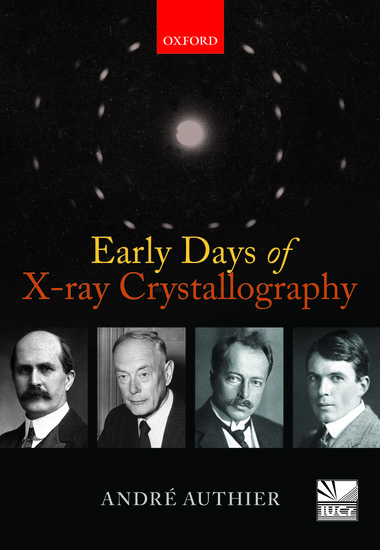By André Authier
This year celebrates the hundredth anniversary of the first crystal structure determinations. On 30 July 1913, the crystal structure of diamond was published by W. H. and W. L. Bragg, father and son, and those of sodium chloride, potassium chloride, and potassium bromide, by W. L. Bragg, the son. They were the first crystal structures determined by X-ray diffraction, and they revolutionized the ideas of the time about chemical bonds in solids.
The determination of crystal structures was made possible by M. von Laue, W. Friedrich, and P. Knipping’s discovery of the diffraction of X-rays by crystals in April 1912, just over a year before, in Munich, Germany. That discovery, which came 17 years after the discovery of X-rays by W. C. Röntgen, really changed the world. It had far-reaching consequences, by making possible the studies of the structure of the atom and of the structure of matter.
Laue, Friedrich, and Knipping had put crystals of copper sulphate and zinc-blende (ZnS) in the beam emitted by an X-ray tube, and had observed discrete diffraction spots. This simple observation showed the wave character of X-rays and confirmed the space-lattice hypothesis of the arrangement of atoms in crystals. M. von Laue was awarded the 1914 Nobel Prize in Physics for his discovery.
The news reached the Braggs in July 1912 at their holiday site on the Yorkshire coast. William Henry Bragg, the father, then 50 years old, was Professor of Physics at the University of Leeds and had recently come back from Australia, where he had been Professor of Physics for 23 years. William Lawrence Bragg, the son, was just 22 years old, and a student at Trinity College, Cambridge. Laue’s experiment puzzled them a great deal, until the young Willie, remembering the lectures of his optics Professor, C. T. R. Wilson, proposed quite a different interpretation of the Munich experiment than Laue had done. He suggested that the observed diffraction spots were due to the diffraction of X-ray waves on the various families of lattice planes which build up crystals.
W. L Bragg calculated the positions of the diffraction spots on the Laue diagram, using the well known equation, now called Bragg’s law, and showed that zinc-blende, ZnS has in fact a face-centred cubic lattice, and not a simple cubic lattice, as had been assumed by Laue. It was this feat that opened up the possibility of determining crystal structures. Bragg’s results were presented at the Cambridge Philosophical Society by the Director of the Cavendish Laboratory, Professor J. J. Thomson, on 11 November 1912. They were a remarkable accomplishment for a 22-years-old man, still a mere student.
The successful interpretation of Laue’s diagram was not the end of the story for W. L. Bragg. He started making experiments of his own, and, during the spring of 1913, recorded in Cambridge Laue diagrams of crystals of alkali halides, zinc-blende, and fluorite, CaF2, while his father, in Leeds, designed the first X-ray spectrometer, using an ionization chamber.

Together, father and son determined the structure of diamond, also using both Laue diagrams and spectra recorded with the ionization chamber. They showed that the carbon atoms are located at the centres of tetrahedra, the summits of which are also occupied by atoms of carbon. The resulting structure is shown in Figure 2, below.

The structure of alkali halides was not so easily accepted by chemists. There are no individual molecules, neither in diamond nor in sodium chloride: every carbon atom is linked to four carbon atoms in diamond; in sodium chloride, each chlorine is surrounded by six sodium and each sodium by six chlorine, and this throughout the volume of the crystal. The crystal is therefore in itself a single molecule. This went strongly against the molecular theory of the chemists. The German chemist P. Pfeiffer noted in 1915 that ‘the ordinary notion of valency didn’t seem to apply’, and fourteen years later, the influential chemist H. E. Armstong still found Bragg’s proposed structure of sodium chloride ‘more than repugnant to the common sense, not chemical cricket’!
X-ray diffraction produced a microscope with atomic resolution that does not show the atoms themselves, but their electron distribution. It has opened the way for entirely new developments in solid-state chemistry, solid-state physics, mineralogy, geosciences, materials science, and biocrystallography. Thanks to X-ray diffraction, the structure of the semiconductors used in the microelectronic devices was discovered, a classification of the silicates abundant in the earth’s crust could be established, and were determined the structure of DNA and of the big proteins responsible for the cycle of life. It is now used routinely in the development of new drugs.
W.H. and W.L. Bragg were awarded the 1915 Nobel Prize in Physics, for their services in the analysis of crystal structure by means of X-rays. More than 20 Nobel Prizes were awarded for work using X-ray or electron diffraction, the latest being the 2012 Nobel Prize for Chemistry awarded to R. Lefkowitz and H. Hughes for studies related to the crystal structure determination of ‘G-protein-coupled receptors’.
André Authier is Professor Emeritus at the Université P. et M. Curie, Paris, and a member of the German Acazdemy of Sciences, Leopoldina. He is a former President of the Internaational Union of Crysrallography (1990-1993). His book, Early Days of X-ray Crystallography, is published by Oxford University Press.
Subscribe to the OUPblog via email or RSS.
Subscribe to only physics and chemistry articles on the OUPblog via email or RSS.


There is an error in the last sentence of yoru text. The Nobel prize was not awarded to R. Lefkowitz and H. Hughes but to R. Lefkowitz and B. Kobilka.